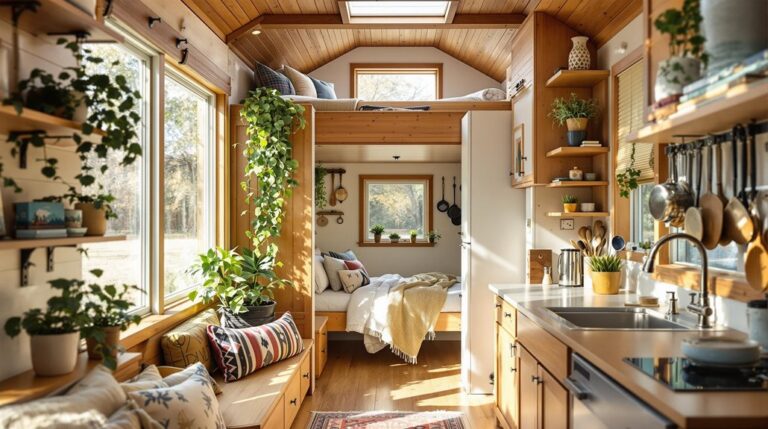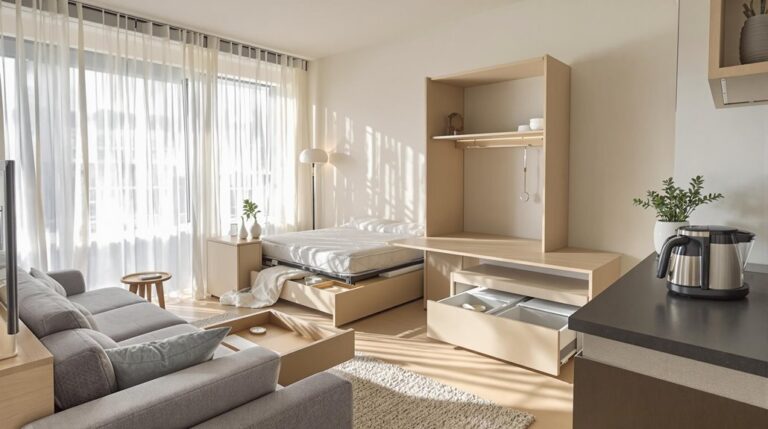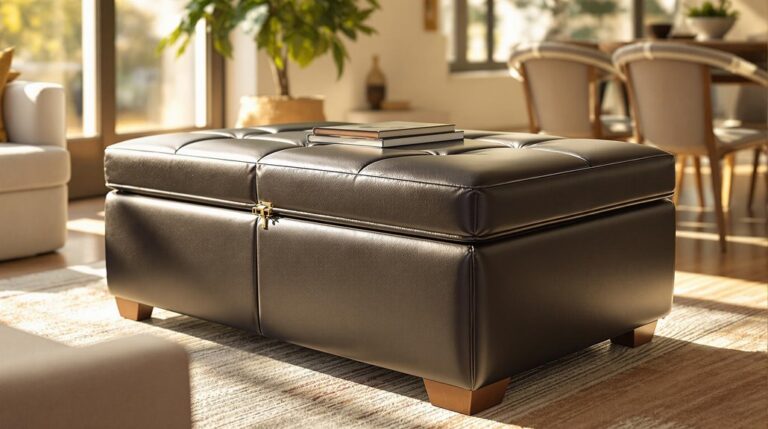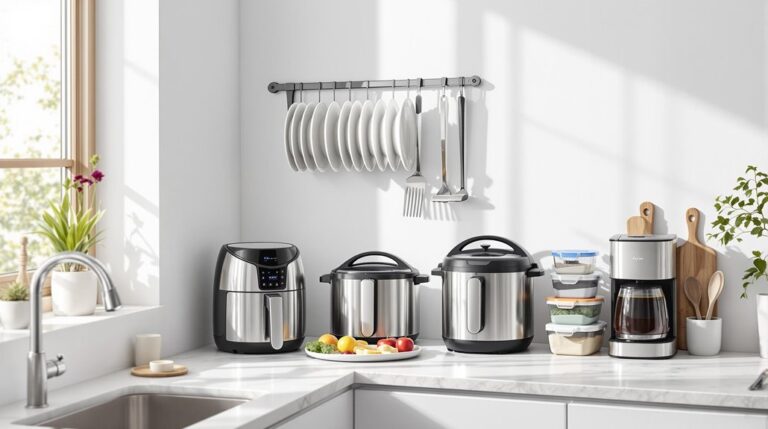The challenge of downsizing extends beyond simply reducing possessions. It requires thoughtful consideration of storage solutions that maximize limited space while maintaining functionality. Today’s market offers innovative products designed specifically for smaller living environments, from multi-functional furniture to vertical storage systems. These tools enable individuals to organize belongings efficiently without sacrificing comfort or accessibility. The right storage products can transform downsizing from an overwhelming task into an achievable lifestyle change.
Key Takeaways
- Multi-functional furniture with storage compartments eliminates clutter while maintaining essential living space functions.
- Vacuum storage bags compress textiles to 20% of original volume, ideal for seasonal clothing during downsizing.
- Vertical storage solutions utilize wall and ceiling space, maximizing limited square footage in smaller homes.
- Digital inventory apps help catalog and track belongings, facilitating systematic decluttering decisions.
- Underbed storage containers utilize overlooked spaces for storing seasonal items without sacrificing living areas.
Space-Saving Containers for Seasonal Items

When downsizing a living space, effective storage solutions become essential for managing seasonal items that aren’t needed year-round. Underbed storage containers maximize overlooked spaces, providing accessible homes for holiday decorations or winter clothing without consuming valuable closet real estate.
For ideal seasonal storage, consider categorizing items by holiday or season, then implementing a rotation system that allows for systematic retrieval when needed.
Stackable plastic totes with reinforced lids offer durability in attics and garages, while airtight options protect sensitive fabrics from moisture damage.
Container organization becomes manageable when utilizing clear plastic varieties that allow visual inventory without unpacking. Remember to allocate approximately 15-20% extra capacity when selecting containers, ensuring adequate space for future acquisitions while maintaining an efficient storage footprint.
Multi-Functional Furniture Solutions for Small Spaces
As living spaces continue to shrink, multi-functional furniture has emerged as an important investment for homeowners maneuvering the challenges of downsizing.
With average American homes now at their smallest in 13 years, innovative convertible furniture designs maximize functionality without sacrificing comfort or aesthetics.
Sofa beds and modular sectionals dominate the market, offering dual-purpose seating and sleeping arrangements.
Storage-integrated pieces, such as ottomans with hidden compartments or beds with built-in drawers, eliminate clutter while maintaining organization.
For those working remotely, compact office solutions like wall-mounted desks and adjustable-height tables accommodate professional needs without dedicated space.
Materials also play a significant role, with lightweight options prioritizing portability while glass elements create visual openness in tight layouts.
As the market expands at 6.6% annually, manufacturers continue developing innovative solutions that merge practicality with style.
Digital Organization Tools for Physical Belongings
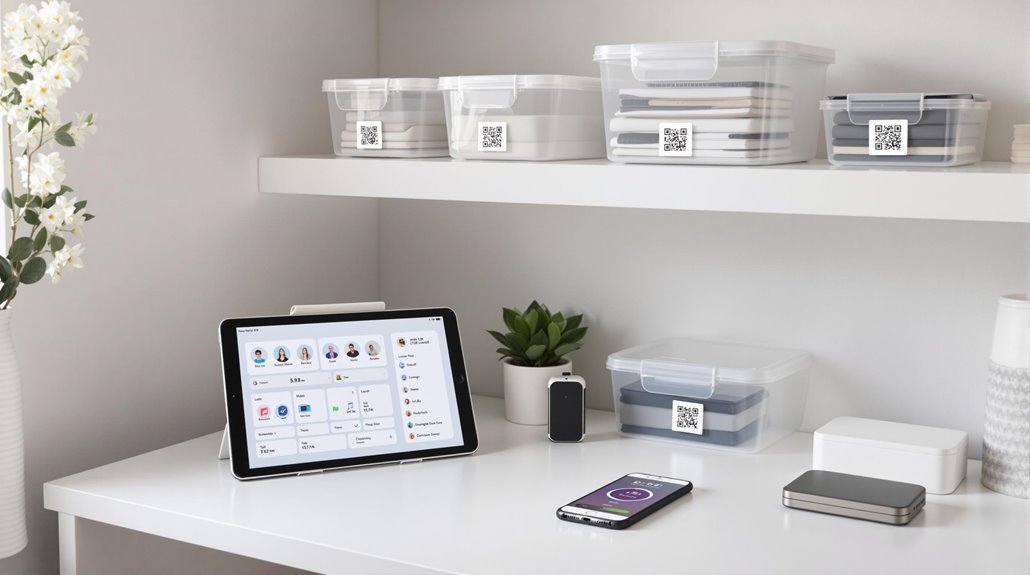
The digital revolution has transformed not only how we communicate but also how we organize our physical possessions during downsizing. Digital inventory apps like Sortly enable users to catalog belongings, track locations, and eliminate duplicates with remarkable efficiency.
When paired with barcode or QR code systems, these tools create seamless connections between physical items and their digital records.
Cloud storage platforms offer secure alternatives for preserving sentimental items without maintaining physical clutter. By digitizing documents, photos, and memorabilia, downsizers can maintain access to cherished memories while freeing up valuable space.
Smart labeling technologies with NFC chips provide real-time inventory updates through mobile devices, while automated workflows through services like Zapier and IFTTT connect organizational systems for thorough management.
These technologies make downsizing more achievable by reducing the cognitive load of tracking belongings across multiple spaces.
Vacuum Storage Systems for Textiles and Clothing
Vacuum storage systems represent one of the most significant innovations in textile management for downsizing households.
These solutions compress clothing and linens to 20% of their original volume, transforming bulky seasonal wardrobes into compact, stackable packages perfect for limited spaces.
The vacuum benefits extend beyond space efficiency. By creating an airtight environment, these systems provide extensive fabric protection against dust, pests, and humidity while preserving freshness.
However, users should exercise caution with delicate textiles like silk or lace, which may suffer permanent damage from compression. For ideal results, reserve vacuum storage for sturdy materials like wool and cotton, limit storage duration to 3-6 months, and store bags in cool, dry environments.
Those with heirloom garments might consider breathable archival containers as alternatives for items requiring preservation without compression.
Vertical Storage Options to Maximize Limited Square Footage

Vertical storage solutions transform limited living spaces by capitalizing on underutilized wall and ceiling areas, offering downsizing households a practical alternative to vacuum-packed textiles.
Wall mounted racks efficiently store everything from kitchenware to decorative items, reducing countertop clutter while keeping essentials visible and accessible. These systems typically require minimal installation and can be adapted to rental properties using temporary attachment methods.
Ceiling shelves represent another dimension of spatial efficiency, providing storage for seasonal items or rarely-used possessions that would otherwise consume valuable floor space.
For maximum organization, experts recommend categorizing belongings by frequency of use, keeping everyday items at mid-height levels. Corner-maximizing designs with angled brackets further optimize tight spaces.
These vertical solutions not only conserve square footage but also create visually balanced environments that make downsized living feel spacious and intentional.
Modular Systems That Adapt to Changing Storage Needs
As households shift between life stages, modular storage systems offer unparalleled adaptability for evolving organizational needs, allowing homeowners to invest incrementally rather than committing to permanent built-ins that may quickly become obsolete.
Modular shelving units represent an intelligent solution for downsizers, offering both immediate functionality and future flexibility. These systems can be expanded, contracted, or reconfigured as storage requirements change, without the costs associated with replacing entire storage infrastructure.
Recent market projections indicate substantial growth in flexible storage options through 2032, reflecting widespread recognition of their practical benefits.
The versatility of these systems extends beyond mere capacity—they maximize available space through efficient design while supporting diverse storage needs.
For homeowners managing changes, modular components provide cost-effective adaptability that traditional storage solutions simply cannot match.
Frequently Asked Questions
How Do Storage Solutions Affect Home Insurance Premiums?
Storage solutions can influence home insurance premiums through detailed risk assessments.
Climate-controlled units with enhanced security features may qualify for insurance discounts, while units in disaster-prone areas typically increase rates.
Off-premises coverage typically limits protection to 10% of personal property coverage.
Homeowners should regularly update inventories and consider additional endorsements for valuable items, as proper documentation guarantees appropriate coverage and potentially lower premiums.
Can Climate-Controlled Storage Prevent Damage to Valuable Antiques?
Climate-controlled storage provides essential protection for valuable antiques by maintaining consistent temperature and humidity levels.
This stability prevents common deterioration issues like wood warping, metal corrosion, and fabric degradation.
Proper antique preservation requires environmental conditions that minimize exposure to damaging fluctuations, which accelerate aging processes and reduce value.
Professional facilities offer specialized settings that shield irreplaceable items from seasonal changes, preserving both their historical significance and financial worth.
How Should I Divide Possessions During Divorce When Downsizing?
Effective possession division during divorce requires balancing practicality with emotional attachment.
Couples should categorize items by necessity, sentimental value, and financial worth before negotiating. Creating a detailed inventory helps identify what each person truly needs in their new space.
Professional mediators can facilitate difficult conversations when attachments run deep.
Prioritizing needs over wants and considering the spatial limitations of new living arrangements makes downsizing more manageable during this challenging shift.
What Percentage of Stored Items Are Never Retrieved?
While exact retrieval rates for stored items vary across facilities, industry estimates suggest approximately 25-30% of items placed in storage units are never retrieved by their original owners.
Financial hardship, life changes such as divorce or relocation, and simple forgetfulness contribute to this abandonment pattern.
Most facilities auction these unretrieved items after a specified period of non-payment, turning the unfortunate circumstances of previous renters into potential opportunities for auction buyers.
How Have Storage Needs Shifted With Remote Work Trends?
Remote work trends have dramatically shifted storage needs, with employees requiring flexible storage solutions that accommodate compact home environments.
The rise in remote workspaces has created demand for multi-functional furniture that separates professional and personal spaces.
As 75% of employees now work from home at least part-time, storage systems must address both physical document management and digital security concerns, while supporting productivity in shared living arrangements.
Bottom Line
Downsizing successfully relies on strategic storage solutions that maximize functionality while minimizing spatial requirements. By implementing multi-functional furniture, vertical storage options, vacuum systems, and modular components, individuals can transform cramped quarters into organized, livable environments. Digital organization tools further streamline the process by tracking physical belongings. With these innovative products, downsizing becomes not just possible, but a practical pathway to a more efficient, clutter-free lifestyle.
